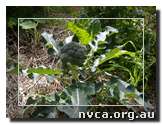| Home |
Why a GE Free Nambucca?
Genetic engineering (GE) is ecologically unsustainable and unacceptable - it threatens human health, ecological integrity and economic viability. Yet, despite widespread public opposition, the Office of the Gene Technology Regulator (OGTR) and Food Standards Australia New Zealand (FSANZ) continue to allow genetically engineered organisms into our fields and onto our plates.
The approval processes for genetically engineered crops and foodstuffs do not consider whether or not they are ecologically sustainable nor if they will affect human health in the long term. Creating such risks to our environment, our health, and our economy is unacceptable – we need to ensure any agricultural development is ecologically sustainable for both present and future generations.
Organic agriculture holds the promise of sustainability – a more healthy society, a less polluted environment and increased economic opportunity. Genetic engineering and organic agriculture cannot co-exist – therefore we need to choose which path we will take.
Download GE Information Booklet and Report
Our GE-Free Future
Published by NCVA 2009. Click to download Booklet. (2mb pdf)
An Indepth Report on GE
Published by NCVA 2009. Click to download Report. (6mb pdf)
What is Genetic Engineering?
GE allows scientists to move, delete, modify, construct or multiply genes within a new or existing organism. In other words, GE allows scientists to create organisms that do not occur naturally. To do this, scientists isolate the desired gene, attach it to a carrier (which is usually a virus) and insert it into the plant or animal. Usually, an antibiotic marker gene is also inserted to allow scientists to tell if the engineering has been successful.
One technique used to insert this combination is called micro-projectile bombardment: using a special gun, scientists attach the new gene to a tiny piece of gold or tungsten and shoot it into the host organism – for example, a cow or canola plant.
Most controversially, GE allows scientists to cross the barriers that have kept species apart for millions of years: this type of GE is known as ‘transgenics’. Numerous transgenic creations already exist – scientists have mixed strawberries with Atlantic flounder genes to make strawberries frost-resistant and combined luminescent jellyfish with fish in order to make glow-in-the-dark fish. Scientists have made plants survive being sprayed with deadly chemicals, and have even started putting human genes into cows to make babies’ milk.
Is GE Sustainable?
To be environmentally sustainable, GE should help maintain ecological processes, life-support systems and protect biodiversity. Yet the fertility of GE organisms threatens to disrupt ecosystems and lead to the displacement and extinction of existing species.
In the case of GE salmon, compared to their natural counterparts, their heightened growth rate and faster feeding ability means that this GE organism has the potential to pass genes onto wild relatives and to out-compete its natural counterparts.
Insecticide and herbicide resistance poses further threats to environmental stability. Insects can become resistant to the engineered plants, and have already shown such resistance to INGARD® cotton in Australia. Viruses can re-combine with transgenes and create new and stronger strains that require new methods to be developed to control them.
GE in our Backyard
Trial crops of genetically engineered (GE) roses, cotton, wheat, rice, papaya, Indian mustard, sugarcane, canola, carnation, grapevine, pineapple and poppy have been grown in Australia since at least 1995. Unrestricted commercial cultivation of GE carnations and cotton in Australia occurred in 1995 and 1996. The NSW government recently lifted the GE moratoria on the commercial cultivation of GE canola despite 57% of people surveyed opposing it.
Like other NSW local government areas, the Nambucca Shire is not safe from GE organisms. While no GE crops are currently grown here, both human and animal food that contains GE ingredients are sold in the Nambucca Shire.
The Office of the Gene Technology Regulator (‘the Regulator’) – the body that oversees the introduction of GE organisms - wrote to Nambucca Shire Council (NSC) twice during 2007 and asked for comment on the commercial release of GE cotton and on the commercial release of a transgenic ‘glofish’. Council did not comment. However, there is opportunity for local governments, including the Nambucca Shire Council, to act, and declare their regions Genetic Engineering Free Zones.
The Organic Alternative
Trial release of GE organisms comes at the expense of the stability or our environment, the welfare of our people, and the viability of our economy. The current regulatory regime fails to look at whether GE is ecologically sustainable, and the GTR’s risk-based approach is flawed. If we are to ensure our wellbeing, both now and into the future, we need to embrace an alternative and much more sustainable way of farming.
The Nambucca Shire Council can, and should, promote sustainable alternatives such as organic agriculture. After all, GE and organic agriculture cannot co-exist and the organic industry is already well established in the shire. However, to protect our existing industry and to encourage the growth of the organic industry requires council to take action. Coouncil needs to declare the Nambucca Shire to be a Genetic Engineering Free Zone, and to make the necessary amendments to its Local Environment Plan. Anything short of this recommendation is unacceptable.
What our councils can do
All local governments have an obligation to ensure the principles of ecologically sustainable development (ESD) are met in their shires. Many NSW local government bodies including Coffs Harbour, Newcastle and Byron Shire have taken a stance against GE. These Councils have declared their regions to be GE Free Zones or have expressed opposition to GE. Actions taken include adoption of the precautionary approach and amendment of their Local Environment Plan to reflect their position on GE. Nambucca Shire Council can, and should, do the same.
Local Government Association policy states that “Until irrefutable evidence is provided which demonstrates that there are no adverse direct or indirect impacts of genetically modified crops, the Local Government Association remains opposed to their use in any area. Each local government area be given the right to declare itself a genetically modified free zone.” - Local Government Association Policy Statements, 2005.
What we can do
There are many things we can do, both as individuals and collectively to help stop the spread of GE plants, both in our environment and in our food. Learn about GE, read the labels on the food you buy, write a letter to council, write to the Federal Government.
You can also support locally grown food, support seed saving groups, support groups who oppose GE and buy organic or better still, grow your own food. |
|






